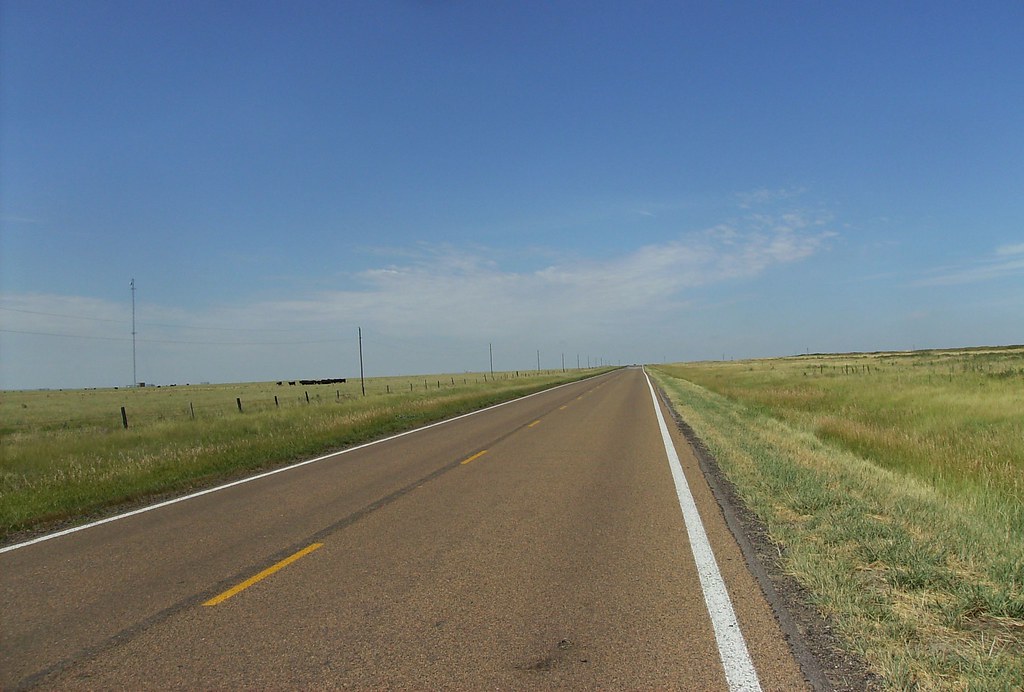Loyal reader Mr. Burns pointed out that my intended Dust Bowl route will traverse a psuedo-geo-oddity. I’ll move from Central Time to Mountain time while heading due north. That happens in other places sporadically, although not as rarely as moving east from Mountain Time into Pacific Time for example. One can’t be too choosy in this depopulated corner of the nation so I will take what I can get. Mildly unusual works for me.

The whole concept of Mountain Time in Kansas feels strange. Maybe it’s the name. The thought of referencing jagged peaks in a Great Plains state like Kansas seemed alien and out of place. Nonetheless, four of Kansas’ 105 counties on its westernmost edge do in fact observe Mountain Time. Many others used to do the same in previous decades.
Most interstate travelers probably enter Mountain Time in Kansas while driving along Interstate 70. It begins about 35 miles before they hit Colorado. There is a simple green sign announces the change. Mountain Time includes Sherman, Wallace, Greeley and Hamilton Counties.
I will likely clip only the southernmost of those counties, namely Hamilton. Even the small rural road I plan to use appears to have a time zone notice (street view). So it shouldn’t come as a surprise when I get there.
Definition
Time Zones are defined in Title 49 of the United States Code of Federal Regulations, which deals with Transportation. That’s an historical artifact reaching back to the rise of railroads. Naturally they depended on standard times to define passenger and freight schedules.
According to the Department of Transportation, standard times were created in 1883 and each location could select its preferred time. Then it switched to Federal oversight in 1918 under the Interstate Commerce Commission. Finally it shifted to the Department of Transportation upon its creation in 1966.
49 CFR 71.1 clearly defines the Kansan portion of Mountain Time. Feel free to read the code if you simply must know the pertinent details.
Reasoning
Consult a map and it’s easy to understand why a few Kansas counties continue to cling to Mountain Time.
Goodland is a Kansas town within the Mountain Time zone. It sits astride I-70 about 200 miles (322 km) east of Denver, the capital of neighboring Colorado. Likewise, Goodland is 344 miles (554 km) west of Topeka, the capital of Kansas. Finally it’s 406 miles (653 km) from the state’s largest metropolitan area, Kansas City. Clearly Goodland has an incentive to skew towards Denver rather than Kansas City. Nonetheless the notch can lead to time confusion.
The best, in fact the only article I found that addressed this situation came from the Rocky Mountain News in 2008 — “Clock Change a Daily Challenge in Part of Kansas.” It’s worth a read if you have access to the newspaper archive; it doesn’t appear to be available on the Internet anymore.
Shifts Over Time
Mountain Time in Kansas continued to shift increasingly westward over the last hundred years. It used to run much closer to the 100th Meridian, a traditional division between east and west not only in the United States but also in Canada. Notice the current area of Kansas in Mountain Time (shaded). Compare that to the boundaries recognized by various railroads in 1908, the black lines.
Railroads focused on their tracks and not on the surrounding countryside. Unfortunately that makes it difficult to reconstruct an exact historical time zone boundary line. So the dark horizontal lines should be viewed as rough approximations exaggerated in length to enhance visibility.
Dodge City
Dodge City was one of those places on the boundary a hundred years ago. The town and its residents observed Central Time, which was their prerogative during the period before Federal oversight.
The Atchison, Topeka & Santa Fe Railroad defined time a little differently. They drew a line precisely through the Dodge City railway station. Trains heading east from this point recognized Central Time. Trains heading west recognized Mountain Time. The railroad constructed two large decorative sundials on either side of the figurative line to recognize the distinction. This served as a visual reminder to passengers and crew alike. Those same sundials still stand at the station today, recently restored, an artifact of a period when Mountain Time cut much deeper into Kansas. Both sundials appear in the satellite image above.
I couldn’t find a photo with a Creative Commons license to embed on this page so feel free to open a new tab to view one on Flickr. They wanted to charge $35 for a license to embed it here. Sheesh!
Momentum is pushing all of Kansas into Central Time. Nonetheless, the four holdout counties don’t seem to be in much of a hurry to switch.

Leave a Reply